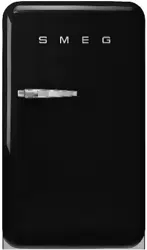Loading ...
Loading ...
Loading ...

Cleaning and maintenance
23
EN
Defrosting the freezer compartment
The freezer compartment needs to be
defrosted manually. When the thickness of
frost or ice on the shelves exceeds 2 cm, the
freezer should be defrosted.
A few hours before defrosting, proceed as
follows:
1. Set the thermostat on 5 for a further
cooling of frozen foodstuffs.
2. Turn the knob to the position 0.
3. Disconnect the appliance from the
mains power supply.
While cleaning, remove frozen foodstuff
from the freezer and protect them from
defrosting; then, place a container under
the defrosting water drain channel.
After defrosting, dry the freezer
compartment completely.
4.4 What to do if...
The appliance does not work:
• Make sure that the appliance is plugged
in and that the main switch is turned on.
The compressor starts to function too often
or functions continuously:
• The room temperature is too high.
• The door is being opened too often or
for too long.
• The door is not closing/sealing properly.
•The freezer is loaded with too many fresh
foods.
• Check that sufficient air can circulate
around the sensor on the right-hand side
of the refrigerator compartment.
• Check that the back of the freezer is
properly ventilated and that the
condenser is not too dirty.
Excessive ice or condensation has built up
inside the refrigerator compartment:
• The door is being opened too often or
for too long.
• Fresh food (fruit and vegetables) has
been placed inside the refrigerator
compartment.
• Food not properly covered or stored in
hermetically closed containers.
• The foodstuffs or containers are in
contact with the rear wall.
• The door seal is damaged or dirty.
To clean the seal use lukewarm water
and then dry it.
Water is forming inside the refrigerator
compartment:
• The drainage channel or opening is
blocked.
NOTE:
The amount of ice which forms on
the back wall may vary with
changes in weather conditions, the
frequency with which the door is
opened, the appliance's operating
temperatures and the amount of
fresh foods stored inside
(especially fruit and vegetables).
Loading ...
Loading ...
Loading ...
